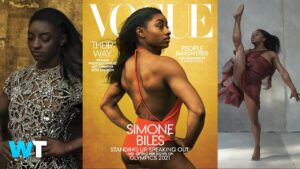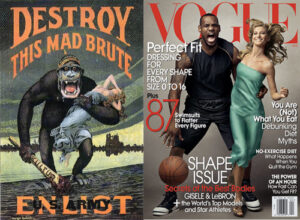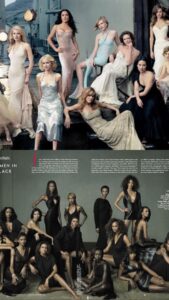
Last month, Vogue magazine released its latest issue, featuring a controversial portrait of the world-renowned gymnast Simone Biles. Condé Nast — Vogue’s parent company — is notorious for its questionable, culturally appropriated magazine covers, and so is the famous photographer Annie Leibovitz, who did the photo shoot with Biles. This isn’t her first controversial photo shoot with a culturally significant Black figure.
The shoot captured by the 70-year-old photographer caught the attention of numerous vehement individuals. Many claimed Leibovitz’s muted tone was degrading to Biles’ skin tone and Black culture’s essence. With thousands of photoshoots under her belt, most thought that Leibovitz’s work for Biles would’ve been better considering Leibovitz’s experience and the four-time Olympic gold medalist’s heartfelt story.
The controversy behind this distinctive shoot had some celebrities, photographers, and other personalities question the legitimacy of having a non-person of color capture the art and significance of a person of color. Seemingly to some, Leibovitz may not have taken much consideration of how the Black community would’ve perceived her lighting choice to highlight a prominent Black woman’s story compared to other figures she has portrayed in the past who weren’t people of color.
“Photography can be controversial in this generation when photographers don’t think critically about the people they are making photos of. Specifically, when we are photographing the most vulnerable populations of our communities,” Tori Lynn Schneider, a news photographer/videographer at the Tallahassee Democrat, said. “You can capture a great moment, but if the composition or light don’t lend themselves to easy viewing on the eye, that great moment can get lost to the viewer.”

As Schneider says, the best photographs have light, composition, and a great moment; some can assume that Leibovitz does not believe these three components are key elements to great photograph. A prime example is her representation in one of the most criticized and controversial magazine covers with LeBron James— the first-ever Black man to be on a Vogue cover — alongside a supermodel. Many critics professed the photo was a modern version of the 1917 American war propaganda poster “Destroy This Mad Brute.”Another cover that many in the Black community arguably think Leibovitz did not consider.
The Black community believes that Leibovitz’s muted toning is mostly used on African-Americans in comparison to most of her shoots with non-people of color. A prime example is her 2001 Top Model shoot of all Black women, which resembles a similar tone to Simone Biles and LeBron James, compared to her April 2004 shoot of all white women, shot in a more broad daylight tone.
Though Leibovitz’s work isn’t always in her famous style, she is best known for photographing well-known figures, leading to numerous comparisons of the Biles’ shoot with a professional photographer to celebrities and civilians’ shoot with inexperienced photographers. Many were specifically upset about the Biles shoot, not capturing her melanated skin, because of the Vogue challenge created to support the Black Lives Matter movement and Black photographers.

“What she [Leibovitz] failed to do was highlight the essence of her [Biles’] skin, the Black beauty and her being a strong woman,” said the professional student photographer, Malachi Somerville. “I’m more upset with Vogue magazine because I feel that their goal was to capitalize off the Black Lives Matter movement by creating a Vogue challenge that would only help Vogue. It wasn’t to help with Black photographers — it took them 128 years to even hire a Black photographer to shoot one magazine edition in September 2018.”
However, Vanity Fair, a magazine also owned by Condé Nast, recently released its July/August issue with Oscar-winning actress Viola Davis as the cover. The photographer, Dario Calmese, became the first-ever Black photographer to shoot a cover for the 35-year-old magazine. Many gave the shoot honorable recognition; others compared it to Biles’ shoot and how a Black photographer should’ve captured her essence.
While some are still criticizing Leibovitz’s photography, several are coming to her defense with how the Biles’ cover resembles the “Black Madonna” of the 13th and 14th centuries. Her die-hard fans also proclaimed how Leibovitz always had this muted tone in photos throughout her previous work.
“She has a very keen way of showing the viewer exactly who the person is. She is photographing without any words or without having seen the person before,” said Kira Derryberry, a professional Tallahassee photographer and company owner. “I think part of the charm of her work is her very naturalist approach to lighting. She uses lots of ambient light in her shots to create mood and then very large modifiers to mimic natural-looking light to blend with that scene. She’s been a major inspiration for me since day one.”
With many still supporting Leibovitz throughout the controversy, Leibovitz has not addressed or commented on it behind her latest work with Vogue’s August issue and neither has Biles.
Arguably, Vogue has some of the most controversial magazine moments in history. The Black community and many others wait to see how Vogue plans to advance with capturing the essence of their community in a better light and non-controversial tone.